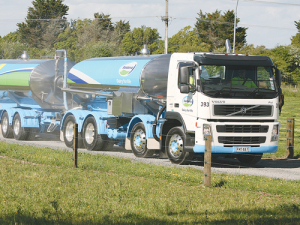Revamped Fonterra to be ‘more capital-efficient’
Fonterra chair Peter McBride says the divestment of Mainland Group is their last significant asset sale and signals the end of structural changes.
 Fonterra’s milk collection across New Zealand for the four months to September is 3% behind the same period last season.
Fonterra’s milk collection across New Zealand for the four months to September is 3% behind the same period last season.
Fonterra’s milk collection across New Zealand for the four months to September 30 reached 297 million kgMS, 3% behind the same period last season, Fonterra says in its latest update.
September milk collection was 175 million kgMS, 2% lower than September last season.
As a result, the cooperative’s forecast offer volumes on GlobalDairyTrade over the next 12 months for New Zealand products has been decreased by 11,199 MT. Including this latest decrease, Fonterra has reduced GDT offer volumes since August 1, 2016 by 55,481 MT.
North Island milk collection in September reached 110 million kgMS, 5% behind September last season.
“Unfavourable weather conditions continue to impact production across most dairying regions. High levels of rainfall in October have made conditions difficult across many regions, but most noticeably in the central region where daily production is down around 14% compared to last year,” the update says.
South Island milk collection in September reached 64 million kgMS, 3% above September last season. Initial October collections indicate milk volumes in the South Island have begun to decline and may fall below last season, it says.
Fonterra’s milk collection across Australia in September, was 12 million kgMS, 1 million kgMS lower than September last season.
“New season milk collection has been heavily impacted by unfavourable pasture conditions through winter and early spring. While we have new farmer suppliers moving to Fonterra, this increase in supply has been offset by the challenging conditions, with record rainfall seen in some regions,” the update says.
The National Wild Goat Hunting Competition has removed 33,418 wild goats over the past three years.
New Zealand needs a new healthcare model to address rising rates of obesity in rural communities, with the current system leaving many patients unable to access effective treatment or long-term support, warn GPs.
Southland farmers are being urged to put safety first, following a spike in tip offs about risky handling of wind-damaged trees
Third-generation Ashburton dairy farmers TJ and Mark Stewart are no strangers to adapting and evolving.
When American retail giant Cosco came to audit Open Country Dairy’s new butter plant at the Waharoa site and give the green light to supply their American stores, they allowed themselves a week for the exercise.
Fonterra chair Peter McBride says the divestment of Mainland Group is their last significant asset sale and signals the end of structural changes.